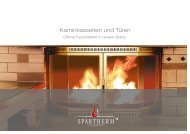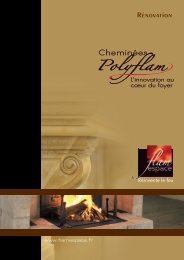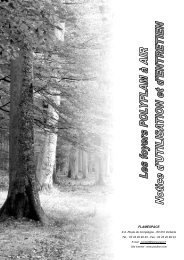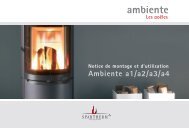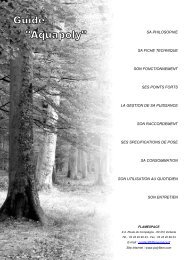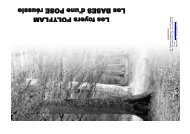Notice d'utilisation foyers vitrés - Flamespace
Notice d'utilisation foyers vitrés - Flamespace
Notice d'utilisation foyers vitrés - Flamespace
Create successful ePaper yourself
Turn your PDF publications into a flip-book with our unique Google optimized e-Paper software.
GB<br />
3.4. COMBUSTION AIR SUPPLY<br />
Open fireplaces may only be installed in rooms that have at least<br />
one door that leads to the outdoors or a window that can be opened,<br />
or are directly next to other rooms or indirectly part of an ambient<br />
air network. For installation in apartments or other facilities,<br />
only rooms in the same apartment or facilities may belong<br />
to the ambient air network.<br />
Open fireplaces may only be set up or installed in the above-named<br />
rooms if at least 360 m 3 combustion air/hour and/m 2 of combustion<br />
chamber opening is able to flow into them. If other fireplaces are<br />
in the rooms where this one is to be installed or in rooms that are<br />
connected to it, according to technical regulations at least 540 m 3<br />
combustion air/hour and /m 2 of combustion chamber opening is able<br />
to flow into all of the open fireplaces and at least 1.6 m 3 combustion<br />
air/hour and /kW total nominal heat capacity into all other fireplaces<br />
for a calculated pressure difference of 0.04 mbar to the outdoors. A<br />
flow speeds of 0.15 m/s is a valid guideline value for dimensioning<br />
the air supply ducts. For a fireplace with a door height of 5260 cm,<br />
this equals an air supply channel of 175 cm 2 , therefore a diameter<br />
of approx. 15 cm.<br />
If the combustion air is not allowed to be removed from the room<br />
(e.g. for buildings with ventilation systems), a coupling has to be<br />
connected to the combustion air lugs on the device. This coupling<br />
has to lead to a different room. (Make sure that this room has a<br />
sufficient supply of air: talk to the building code inspector responsible<br />
and observe DIN 18896 and the German Combustion Ordinance).<br />
If this duct for the combustion air leads out of the building,<br />
it required a cutoff device. The position of the cutoff device has to<br />
be obvious. For this design, the inlet duct should be insulated to<br />
prevent condensate from forming. And the duct should be positioned<br />
so that water and other substances are not able to penetrate<br />
it and any condensate that does form can run off.<br />
COMMENT:<br />
For guidance on realizing a sufficient supply of combustion air, see<br />
the the German Sample Combustion Ordinance (May 1998 version)<br />
and the example of the standard operating procedure for the German<br />
Sample Combustion Ordinance (January 1980 version); the examples<br />
were published in the Institute for Construction Technology<br />
Bulletin no. 3/1980, 17th year (also see comments on DIN 1895).<br />
3.5. COMBUSTION AIR FLUE<br />
As per the specification of the German federal state construction<br />
ordinance that corresponds to § 37, para. 2 of the sample<br />
construction ordinance, combustion air flues in buildings with more<br />
than two full storeys and combustion air flues that bridge firewalls<br />
must be constructed to prevent them from transferring fire and<br />
smoke to other storeys or fire zones.<br />
COMMENT:<br />
For information on how to comply with the above-mentioned specifications,<br />
see the fire inspection guidelines for the fire prevention<br />
requirements of ventilation systems (draft) – January 1984 version.<br />
GB 7



